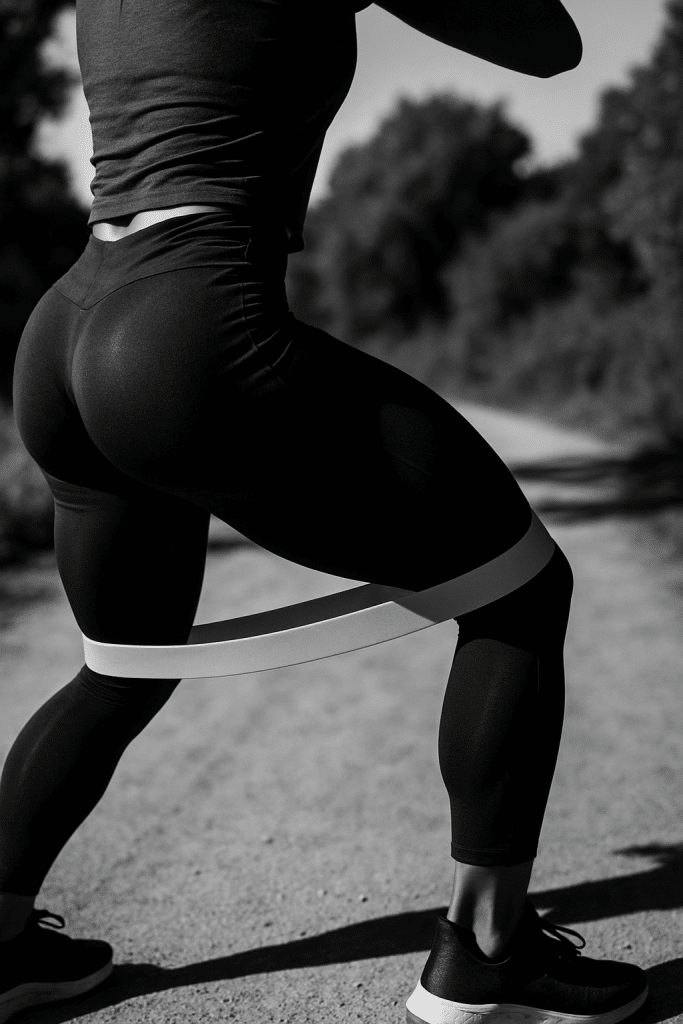If you’re like me, always seeking ways to enhance your lower body workouts without the hassle of bulky equipment, you’ll love what I’m about to share. Resistance band workouts for glutes have quickly become a staple in my fitness routine—and for good reason. These versatile tools activate those hard-to-target glute muscles effectively, whether you’re at home, at the gym, or on the go. Today, I’ll walk you through everything you need to know: from understanding the glute anatomy and the benefits of resistance bands to detailed descriptions of five powerful workouts that really deliver results. I’ll also cover warm-up techniques, progressive overload principles, recovery tips, and how to select the perfect resistance bands for your goals.
Whether you’re a fitness enthusiast aiming to sculpt, tone, or build serious muscle in your glutes, this guide is tailored for you. Let’s dive into the world of resistance band workouts for glutes and unlock their full potential together!
Understanding Glute Anatomy and Muscle Activation
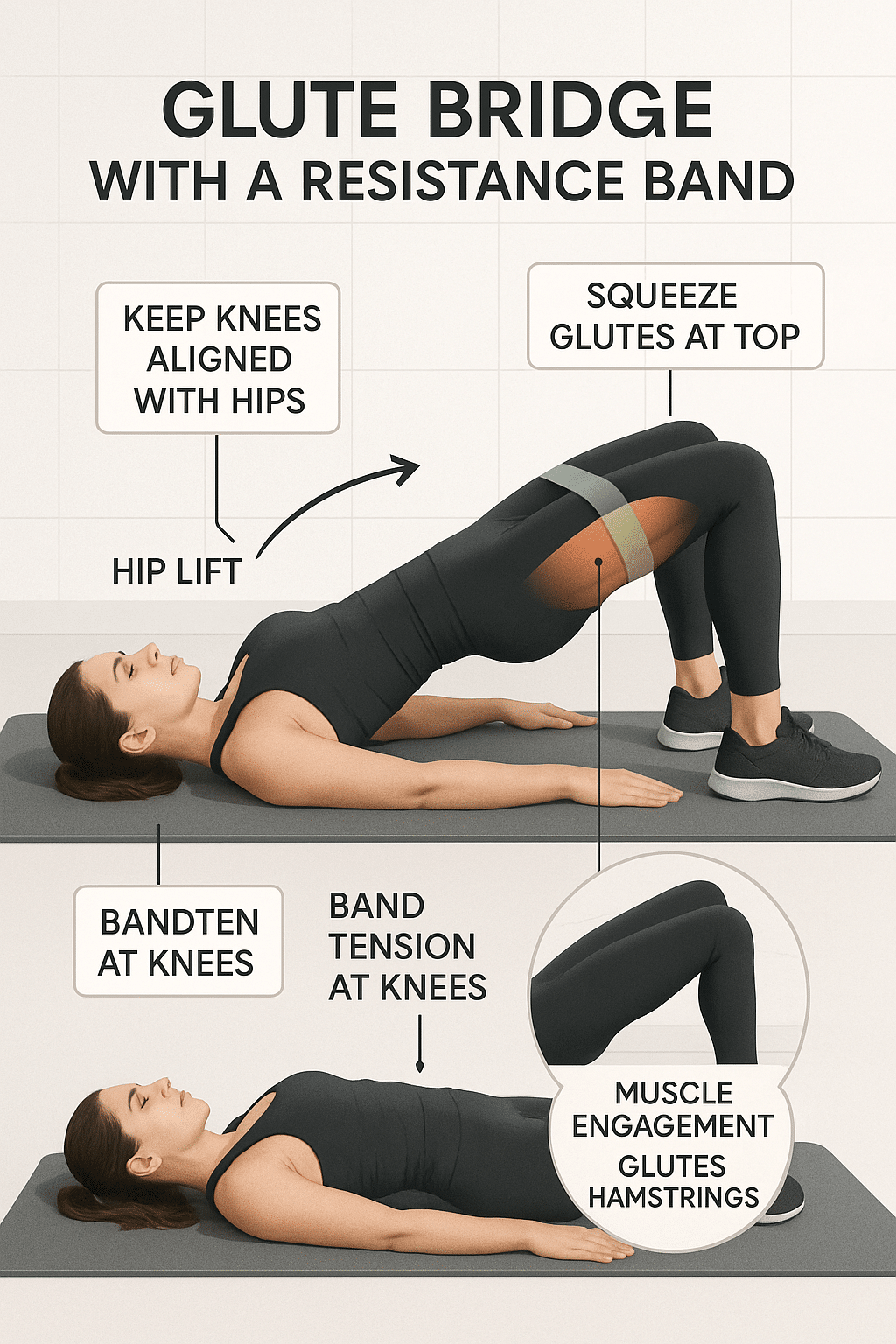
Before we jump into the exercises, let’s get to know the powerhouse muscles we’re targeting. Understanding the anatomy of your glutes and how to properly activate them is key to maximizing your workouts.
The Three Primary Glute Muscles: Maximus, Medius, and Minimus
Your glutes aren’t just one muscle; they’re a group of three major muscles working in concert:
-
Gluteus Maximus: The largest and most powerful muscle of the trio, the gluteus maximus is responsible for hip extension, thigh rotation, and the familiar ‘butt lift’ effect. It’s the main driver for movements like squatting, lunging, and deadlifting.
-
Gluteus Medius: Sitting on the side of the hip, the gluteus medius is essential for hip abduction—moving your leg out to the side—and stabilizing your pelvis during walking or running. A strong medius helps prevent injuries and improves balance.
-
Gluteus Minimus: The smallest of the group, tucked beneath the medius, assists in hip abduction and internal rotation. Though less prominent, it plays a critical role in fine-tuning hip movements.
Knowing which muscle you want to target can transform vague workouts into precise glute activation sessions.
Importance of Mind-Muscle Connection in Glute Training
I can’t stress enough the value of the mind-muscle connection. This means consciously focusing on the glute muscles contracting during every repetition rather than mechanically going through the motions.
For instance, when performing a banded glute bridge, instead of rushing through the movement, really squeeze your glutes at the top and think about feeling that muscle work. Research shows that this mental engagement increases muscle activation, leading to better strength gains and muscular development over time. So, pause, breathe, and connect.
Why Resistance Bands Are Ideal for Glute Workouts
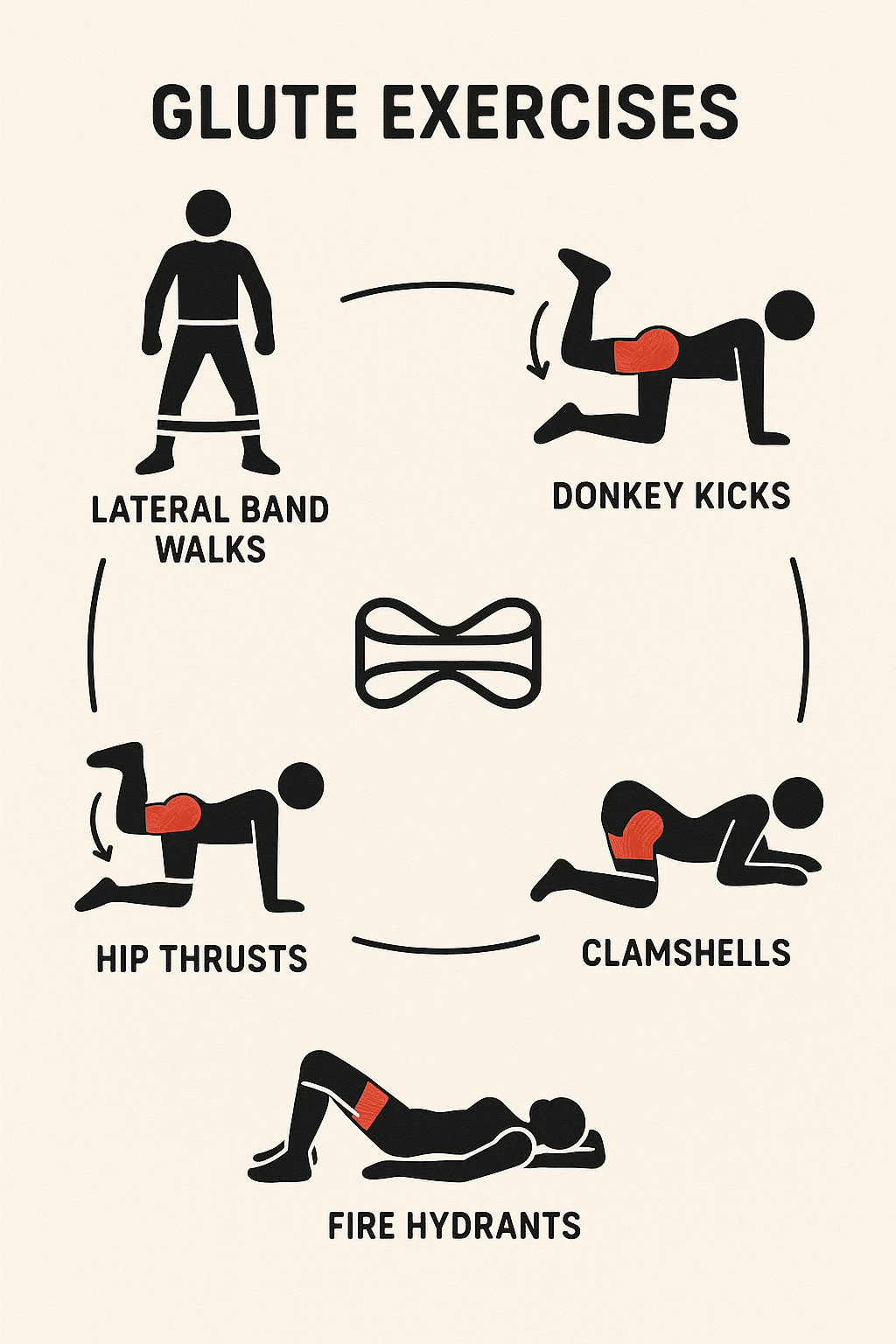
Resistance bands have exploded in popularity for a reason—they make targeting glutes simple, effective, and accessible.
Continuous Tension and Muscle Engagement Benefits
What sets resistance bands apart is their ability to provide continuous tension throughout the entire range of motion. Unlike free weights that rely on gravity, bands stretch and contract, keeping your glute muscles firing from start to finish of each rep.
This continuous load enhances muscle fiber recruitment, especially in the often underworked gluteus medius and minimus. Plus, bands allow you to add resistance in unique movement planes like lateral steps and kickbacks, which are hard to replicate with dumbbells.
Comparing Resistance Bands with Traditional Weights and Bodyweight Exercises
While bodyweight exercises are great for beginners, they often lack the progressive resistance needed for significant muscle growth. Free weights provide that resistance but aren’t always convenient or comfortable, especially for hip abduction exercises.
Resistance bands fill this gap beautifully. They are:
- Portable—You can workout anywhere, anytime.
- Joint-Friendly—Gentle on knees and hips without compromising intensity.
- Versatile—Allow targeted isolation or compound movements.
- Progressive—Vary resistance levels to gradually increase challenge.
Together, these qualities make resistance bands an ideal tool for anyone focused on sculpting the glutes.
Types of Resistance Bands Suitable for Glute Training
Choosing the right bands can elevate your results. Here are some of the top brands and types popular among fitness pros and enthusiasts alike:
-
Fit Simplify Resistance Loop Exercise Bands: These 12″ by 2″ heavy-duty loop bands come with five resistance levels, perfect for beginners to advanced users. They’re affordable, durable, and come with a handy carry bag and instruction guide. (fitsimplify.com)
-
TheraBand Resistance Bands: Known for their color-coded resistance options and high-quality latex or non-latex materials, TheraBands are excellent for varied training needs. Available through multiple retailers like Amazon and Target. (theraband.com)
-
SPRI Xertube Resistance Bands: These versatile tubular bands work great for a wide variety of glute exercises, including squats and hip thrusts, with several resistance levels available. (spri.com)
-
BLACKROLL LOOP BAND: Made from natural rubber with a soft textile cover, the BLACKROLL band offers six resistance levels with a skin-friendly design perfect for small muscle activation and comfort. (blackroll.com)
-
Bodylastics Resistance Bands Set: Featuring durable natural Malaysian latex with safety tech to prevent snapping, these sets include multiple bands with accessories like handles and door anchors. (bodylastics.com)
Selecting a set that offers multiple resistance levels ensures you can progressively overload your muscles and avoid plateaus.
Essential Warm-Up and Glute Activation Techniques Before Band Workouts
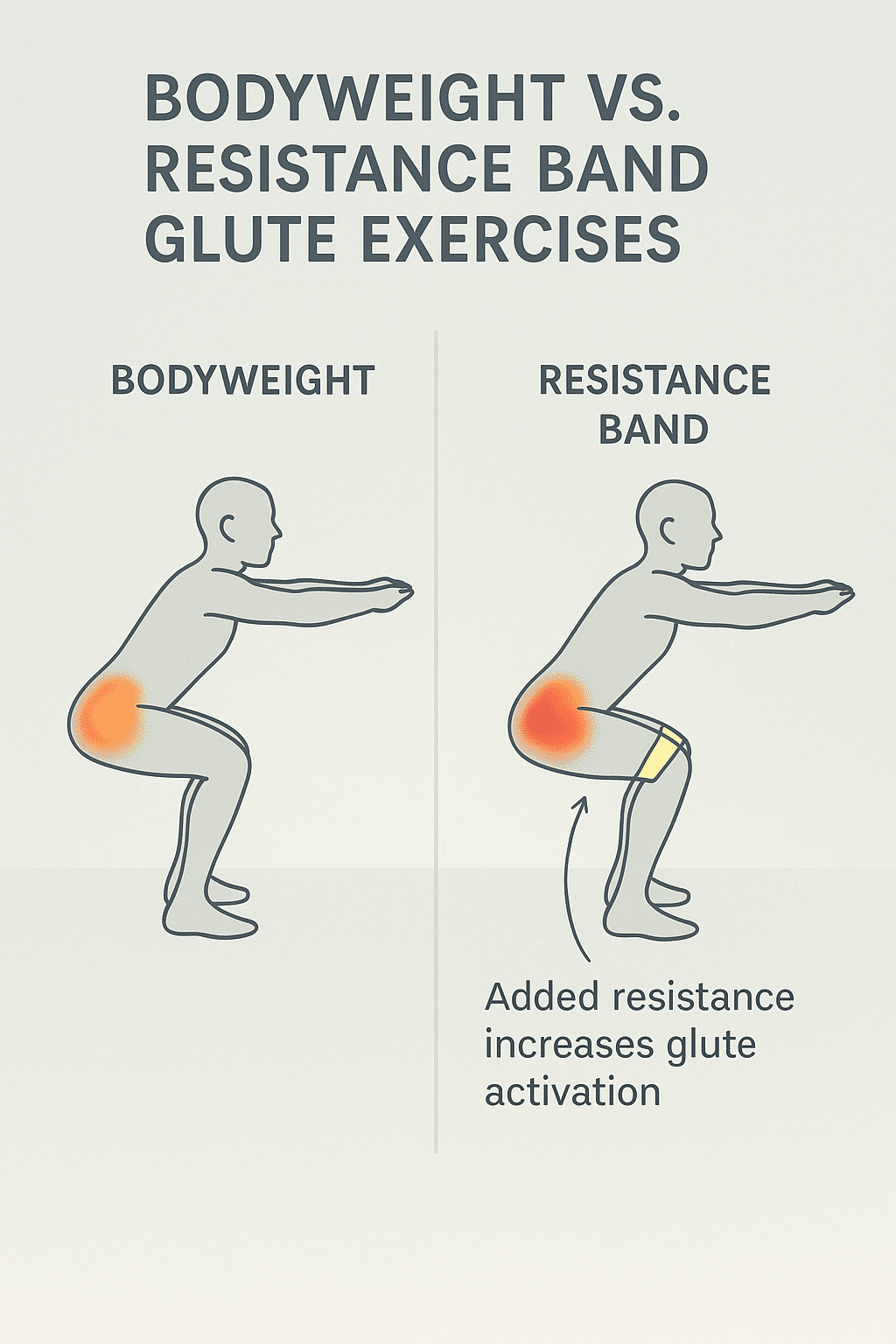
Jumping directly into resistance training without proper preparation can spell disaster. Here’s how I prime my glutes before any heavy resistance band session.
Glute Activation Exercises with Resistance Bands to Prevent Injury
Activation exercises essentially “wake up” dormant glute muscles, especially the medius and minimus, reducing compensation by surrounding muscles like the hamstrings or lower back.
Try these quick drills using a light resistance band:
- Glute Bridge Pulses: Lie on your back, loop a band above your knees, and pulse your hips up in short, controlled movements. Feel the squeeze and keep your core tight.
- Lateral Band Walks: Place the band around your ankles or just above the knees and take small side steps to engage the abductors.
- Clamshells: On your side with a band above your knees, open and close your legs against resistance.
These activation steps only take 5–10 minutes but set the stage for effective glute training.
Recommended Warm-up Routines Focusing on Hip Mobility and Stability
Before resistance training, I do dynamic stretches combining hip mobility work with light cardio such as:
- Leg swings (front-to-back and side-to-side)
- Hip circles
- Bodyweight squats
- Walking lunges with torso twists
Warming up this way improves joint lubrication, increases blood flow, and enhances muscle elasticity, all of which reduce injury risk and boost performance.
The 5 Powerful Resistance Band Workouts for Glutes
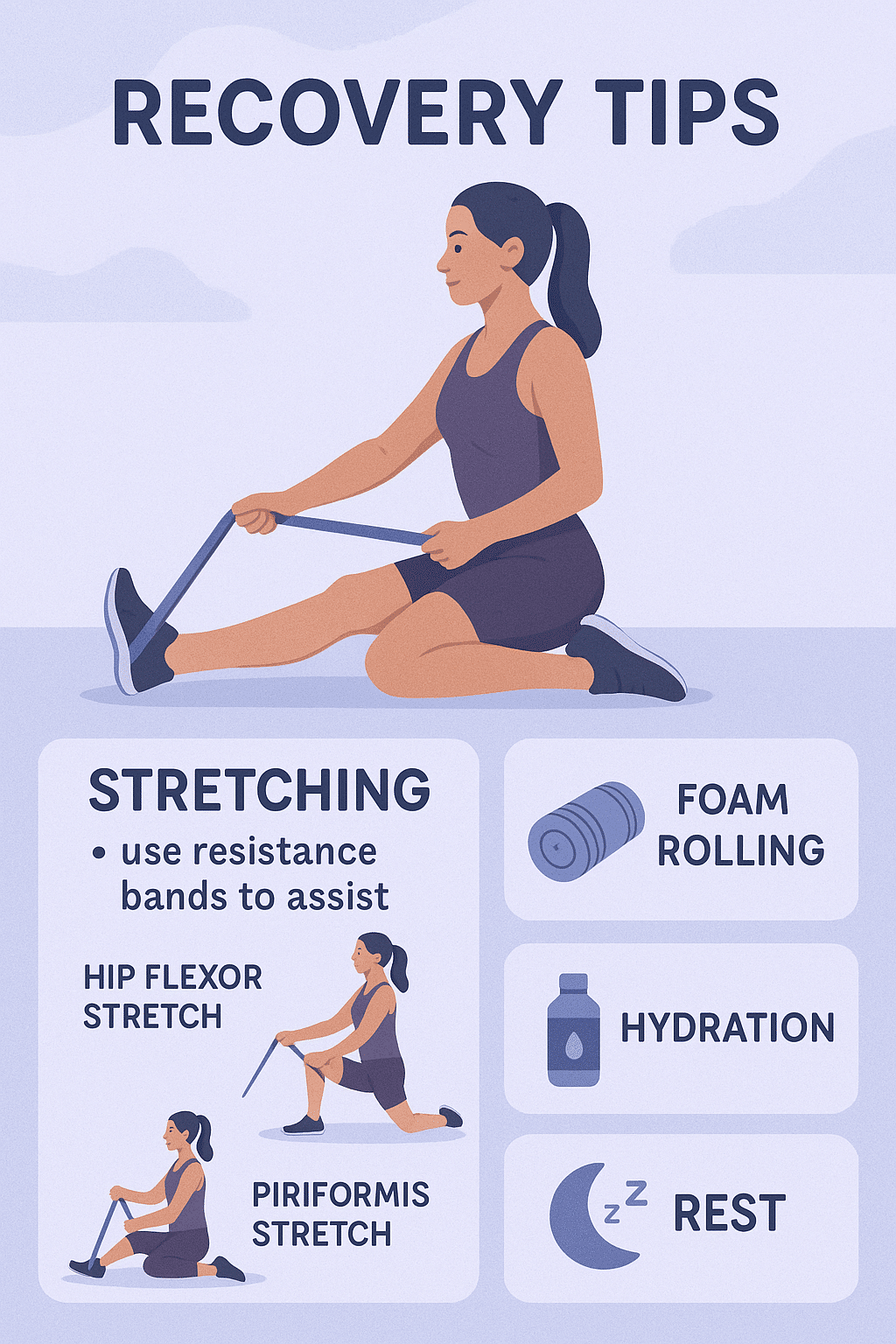
Ready to strengthen and tone your glutes? These five workouts have been game-changers in my routine, each targeting different glute muscles for balanced growth and strength.
Workout 1: Lateral Band Walks (Targets Gluteus Medius)
How to Perform:
- Place a resistance band (Fit Simplify or BLACKROLL loop bands work great) just above your knees or around your ankles, depending on resistance preference.
- Stand with feet hip-width apart to create tension on the band.
- Slightly bend your knees and shift into a half-squat position.
- Step your right foot out to the side, keeping tension on the band, then bring your left foot in to be shoulder-width apart again.
- Take 10-15 steps in one direction, then reverse.
Proper Form and Common Mistakes:
- Keep your chest up and don’t lean forward.
- Avoid crossing feet in front of each other; maintain lateral movement.
- Don’t let knees cave inward—focus on pushing against the band.
Lateral band walks are excellent for improving hip stability and strengthening the gluteus medius, crucial for injury prevention and balanced muscle development.
Workout 2: Banded Glute Bridge (Targets Gluteus Maximus)
How to Perform:
- Lie on your back with a loop band tightened above your knees.
- Bend your knees with feet flat on the floor, hip-width apart.
- Press through your heels as you lift your hips towards the ceiling.
- Squeeze the glutes hard at the top for 2-3 seconds, then lower slowly.
- Repeat for 15-20 reps.
How to Increase Intensity Gradually:
- Use bands with higher resistance, like TheraBand heavy or Bodylastics strong bands.
- Add a single-leg variation by extending one leg while bridging with the other.
- Hold the bridge position longer or add pulses at the top.
The band increases abduction resistance, making this classic move even better at sculpting your gluteus maximus.
Workout 3: Donkey Kicks with Resistance Band (Glute Isolation and Strength)
How to Perform:
- Place a loop band around your thighs, just above your knees.
- Start on all fours with hands under shoulders and knees under hips.
- Keeping your knee bent, lift one leg up toward the ceiling, pressing your heel upward.
- Slowly return to start without touching the knee to the floor.
- Complete 15-20 reps per leg.
This move isolates the glute maximus and is fantastic for building strength and muscle endurance.
Workout 4: Clamshells with Bands (Hip Stability and Medius Activation)
How to Perform:
- Lie on your side with a resistance band above your knees.
- Keep your feet together and knees bent at about 90 degrees.
- Open your top knee as far as possible against the band’s resistance.
- Hold briefly at the peak, then return to start.
- Perform 15-20 reps on each side.
Clamshells are perfect for strengthening the gluteus medius and enhancing pelvic stability—a must for runners and anyone prone to knee pain.
Workout 5: Resistance Band Squats (Compound Movement for Glutes and Legs)
How to Perform:
- Stand on a loop band (Fit Simplify or BLACKROLL mini band is ideal) with feet shoulder-width apart.
- Hold the band’s ends at shoulder height or cross it over your chest for resistance.
- Squat down as if sitting in a chair, keeping your weight in your heels.
- Push through your heels and squeeze your glutes as you stand.
- Complete 12-15 reps.
Incorporating Mini Bands from Fit Simplify or BLACKROLL for Extra Resistance:
Placing a mini band just above your knees during squats forces your glutes to activate more to prevent the knees from caving in, enhancing the workout’s effectiveness. It’s an easy yet powerful upgrade.
Structuring Your Glute Band Workout: Sets, Reps, and Progressive Overload
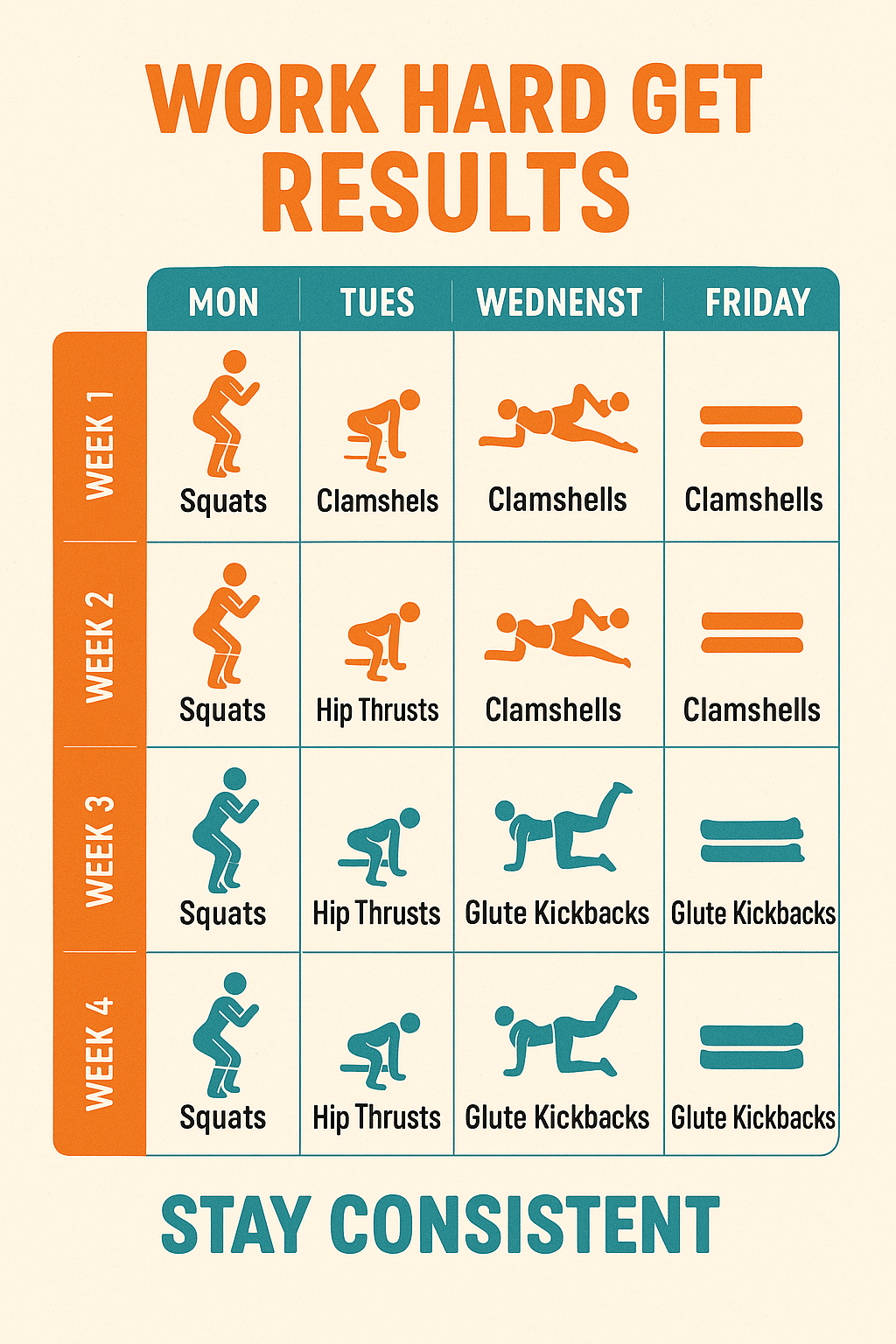
To make meaningful progress, it’s important to plan your workouts thoughtfully.
Designing for Muscle Growth vs. Endurance
- Muscle Growth (Hypertrophy): Focus on 3–4 sets of 8–12 reps with bands providing challenging resistance but allowing full range of motion. Rest 60-90 seconds between sets.
- Endurance: Perform 2–3 sets of 15–20+ reps with lighter resistance, shorter rest, and higher volume.
Both approaches can be integrated across your weekly plan depending on your goals.
Sample Weekly Resistance Band Workout Plans for Beginners to Advanced
| Level | Frequency | Sample Workout | Notes |
|---|---|---|---|
| Beginner | 2 days/week | Lateral Band Walks, Glute Bridge, Clamshell | Use lighter bands, focus on form |
| Intermediate | 3 days/week | Add Resistance Band Squats, Donkey Kicks | Increase reps and band resistance |
| Advanced | 4+ days/week | Combine all 5 workouts, implement progressive overload | Incorporate single-leg variations and HIIT |
Integrating Resistance Band Glute Workouts Into HIIT and Circuit Training
Resistance bands aren’t just for slow strength training—they shine in high-intensity interval training (HIIT) too!
Benefits of High-Intensity Glute Training with Bands
- Time-efficient: Get a full lower body burn in 20–30 minutes.
- Elevated Calorie Burn: Combines resistance with cardio for fat loss.
- Muscle endurance and cardiovascular fitness boost simultaneously.
Example HIIT Circuit Using Fit Simplify and Bodylastics Bands
Repeat each station for 40 seconds, rest 20 seconds, then move on:
- Lateral Band Walks
- Banded Squats
- Donkey Kicks
- Glute Bridge Pulses
- Clamshells
Perform 3-4 full rounds for an intense glute-focused session.
Recovery Strategies Post Resistance Band Glute Workout
Effective recovery accelerates gains and reduces soreness. Here are tips I swear by:
Foam Rolling and Stretching Techniques for Glute Muscles
- Use a foam roller to release tight spots on your glutes and hips.
- Stretch the piriformis, hip flexors, and hamstrings daily.
- Incorporate yoga poses like pigeon or figure-four stretch.
Nutrition and Hydration Tips to Support Muscle Repair
- Prioritize protein intake for muscle synthesis—aim for 20–30 grams post-workout.
- Stay hydrated to help with muscle function and recovery.
- Include anti-inflammatory foods like berries and leafy greens.
When to Rest and How to Manage Muscle Soreness
- Allow 24–48 hours rest between intense glute workouts.
- Use active recovery: light walking or swimming to increase blood flow.
- Apply ice or heat for persistent soreness.
Choosing the Right Resistance Band Set for Your Glute Workouts
Investing in a quality set ensures durability and workout variety.
Comparison of Top Brands
| Brand | Band Types | Resistance Levels | Unique Features | Purchase Links |
|---|---|---|---|---|
| Fit Simplify | Loop bands | 5 levels | Heavy-duty, carry bag, guide included | fitsimplify.com |
| TheraBand | Latex/non-latex flat bands | Multiple color-coded levels | Professional grade, various lengths | theraband.com |
| SPRI Xertube | Tubular resistance bands | Light to heavy | Handles available, versatile | spri.com |
| BLACKROLL LOOP BAND | Loop bands | 6 resistance levels | Soft textile cover, skin-friendly | blackroll.com |
| Bodylastics | Loop and tube bands with accessories | Multiple levels | Snap reduction tech, safety features | bodylastics.com |
Selecting Resistance Levels to Match Your Fitness Level
- Beginners start with lighter bands (e.g., yellow or light green).
- Intermediate users progress to moderate resistance.
- Advanced users choose heavy or extra-strong bands to maintain challenge.
Maintenance and Care Tips for Longevity of Bands
- Store bands away from direct sunlight and heat.
- Avoid overstretching beyond recommended limits (usually triple the resting length).
- Clean with mild soap and water; air dry completely.
- Inspect regularly for tears or cracks to prevent snapping.
Unique Insight: Leveraging Micro-Resistance Variation for Enhanced Glute Activation and Stability
Let me share a little-known technique I use to train smarter: micro-resistance variation within sets.
Using Variable Band Tension Within Repetitions to Maximize Muscle Fiber Recruitment
Instead of keeping the band tension static, slightly vary the length or position throughout reps—for example, adjusting foot or hand placement during a movement—to engage different muscle fibers and highlight weak points.
This creates a nuanced training stimulus, promotes neuromuscular control, and helps break plateaus.
How This Technique Supports Injury Prevention and Functional Strength
Gradually challenging the glutes across a spectrum of tensions improves their ability to stabilize under unpredictable loads—as in sports or daily activity—lowering injury risk while enhancing functional strength.
FAQs
1. What are the best resistance band exercises for glute activation?
Lateral band walks, banded glute bridges, clamshells, donkey kicks, and squats with bands effectively activate all three glute muscles.
2. Can resistance band workouts for glutes build muscle as effectively as weights?
Yes! When progressive overload and proper form are applied, resistance bands can stimulate muscle hypertrophy comparable to free weights, especially for glute muscles.
3. How often should I do resistance band workouts for glutes?
Aim for 2-4 sessions per week, allowing rest days in between for recovery depending on intensity.
4. Are resistance band glute workouts suitable for women over 40?
Absolutely! They offer joint-friendly resistance and can effectively build strength, improve posture, and reduce injury risk at any age.
5. How do I prevent muscle soreness after resistance band glute workouts?
Incorporate a proper warm-up, cool down with stretching, stay hydrated, prioritize protein intake, and allow adequate rest.
Quick Takeaways / Key Points
- Resistance bands provide continuous tension, perfect for activating and strengthening all glute muscle groups.
- Understanding glute anatomy and using the mind-muscle connection improves workout effectiveness.
- Five key workouts—lateral band walks, glute bridges, donkey kicks, clamshells, and squats—form the foundation of a powerful glute routine.
- Warm-up and activation exercises prevent injury and ensure muscles are primed for resistance training.
- Using progressive overload with varied resistance levels is crucial for muscle growth and endurance.
- Recovery through stretching, foam rolling, and nutrition boosts performance and reduces soreness.
- Choose high-quality resistance band sets like Fit Simplify, TheraBand, or BLACKROLL to ensure durability and training versatility.
- Incorporate micro-resistance variation for advanced results and injury prevention.
Conclusion
There’s no doubt in my mind—resistance band workouts for glutes are an excellent way to build strength, enhance muscle tone, and improve hip stability. They are incredibly versatile, accessible, and effective, suitable for fitness enthusiasts of all levels aiming for impressive glute gains. By understanding the underlying anatomy, committing to proper warm-ups, consistently performing targeted exercises with quality bands, and embracing recovery, you set yourself up for lasting success.
So, whether you’re looking to sculpt that perfect booty, prevent injuries, or just feel stronger every day, integrating these resistance band workouts for glutes into your routine is a smart move. Grab a trusted set like those from Fit Simplify or BLACKROLL, start gradually, and watch your glutes transform.
Ready to get started? Let’s band together and make those glutes work!

